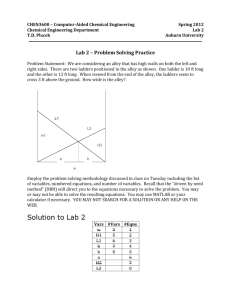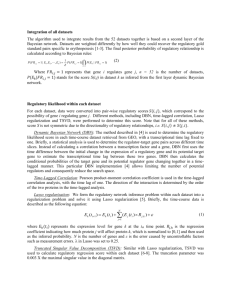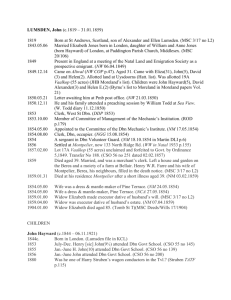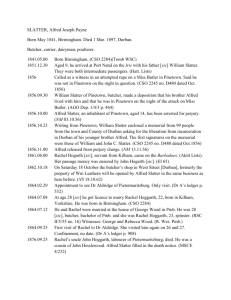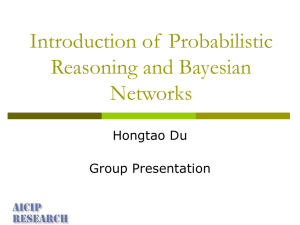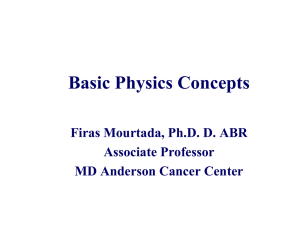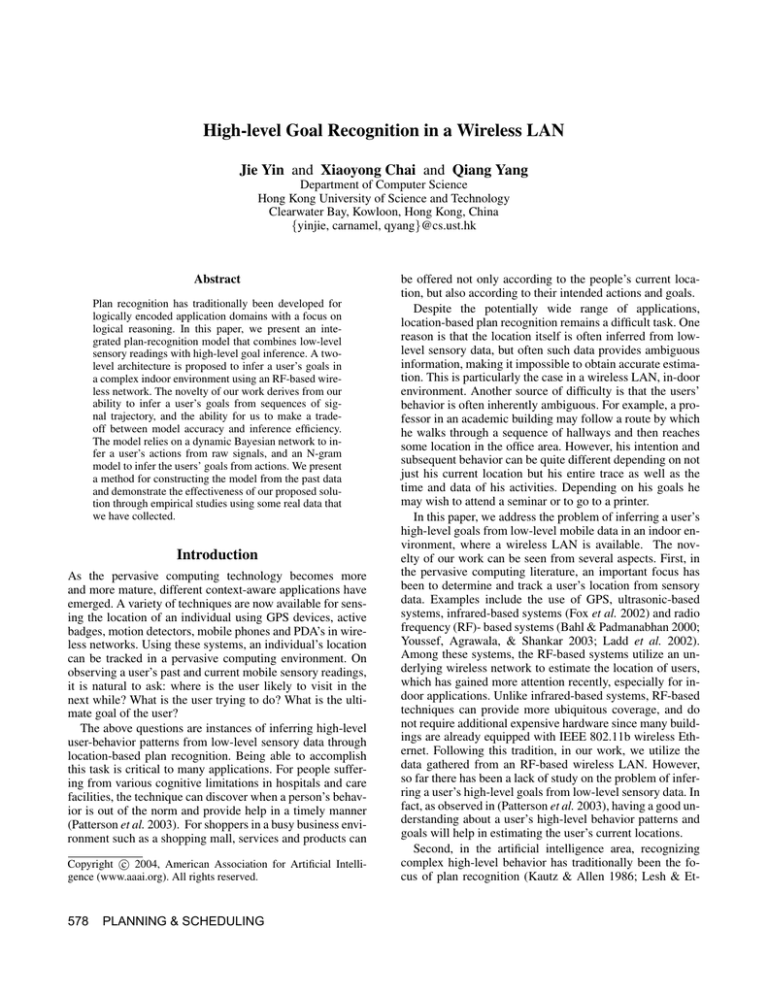
High-level Goal Recognition in a Wireless LAN
Jie Yin and Xiaoyong Chai and Qiang Yang
Department of Computer Science
Hong Kong University of Science and Technology
Clearwater Bay, Kowloon, Hong Kong, China
{yinjie, carnamel, qyang}@cs.ust.hk
Abstract
Plan recognition has traditionally been developed for
logically encoded application domains with a focus on
logical reasoning. In this paper, we present an integrated plan-recognition model that combines low-level
sensory readings with high-level goal inference. A twolevel architecture is proposed to infer a user’s goals in
a complex indoor environment using an RF-based wireless network. The novelty of our work derives from our
ability to infer a user’s goals from sequences of signal trajectory, and the ability for us to make a tradeoff between model accuracy and inference efficiency.
The model relies on a dynamic Bayesian network to infer a user’s actions from raw signals, and an N-gram
model to infer the users’ goals from actions. We present
a method for constructing the model from the past data
and demonstrate the effectiveness of our proposed solution through empirical studies using some real data that
we have collected.
Introduction
As the pervasive computing technology becomes more
and more mature, different context-aware applications have
emerged. A variety of techniques are now available for sensing the location of an individual using GPS devices, active
badges, motion detectors, mobile phones and PDA’s in wireless networks. Using these systems, an individual’s location
can be tracked in a pervasive computing environment. On
observing a user’s past and current mobile sensory readings,
it is natural to ask: where is the user likely to visit in the
next while? What is the user trying to do? What is the ultimate goal of the user?
The above questions are instances of inferring high-level
user-behavior patterns from low-level sensory data through
location-based plan recognition. Being able to accomplish
this task is critical to many applications. For people suffering from various cognitive limitations in hospitals and care
facilities, the technique can discover when a person’s behavior is out of the norm and provide help in a timely manner
(Patterson et al. 2003). For shoppers in a busy business environment such as a shopping mall, services and products can
c 2004, American Association for Artificial IntelliCopyright gence (www.aaai.org). All rights reserved.
578
PLANNING & SCHEDULING
be offered not only according to the people’s current location, but also according to their intended actions and goals.
Despite the potentially wide range of applications,
location-based plan recognition remains a difficult task. One
reason is that the location itself is often inferred from lowlevel sensory data, but often such data provides ambiguous
information, making it impossible to obtain accurate estimation. This is particularly the case in a wireless LAN, in-door
environment. Another source of difficulty is that the users’
behavior is often inherently ambiguous. For example, a professor in an academic building may follow a route by which
he walks through a sequence of hallways and then reaches
some location in the office area. However, his intention and
subsequent behavior can be quite different depending on not
just his current location but his entire trace as well as the
time and data of his activities. Depending on his goals he
may wish to attend a seminar or to go to a printer.
In this paper, we address the problem of inferring a user’s
high-level goals from low-level mobile data in an indoor environment, where a wireless LAN is available. The novelty of our work can be seen from several aspects. First, in
the pervasive computing literature, an important focus has
been to determine and track a user’s location from sensory
data. Examples include the use of GPS, ultrasonic-based
systems, infrared-based systems (Fox et al. 2002) and radio
frequency (RF)- based systems (Bahl & Padmanabhan 2000;
Youssef, Agrawala, & Shankar 2003; Ladd et al. 2002).
Among these systems, the RF-based systems utilize an underlying wireless network to estimate the location of users,
which has gained more attention recently, especially for indoor applications. Unlike infrared-based systems, RF-based
techniques can provide more ubiquitous coverage, and do
not require additional expensive hardware since many buildings are already equipped with IEEE 802.11b wireless Ethernet. Following this tradition, in our work, we utilize the
data gathered from an RF-based wireless LAN. However,
so far there has been a lack of study on the problem of inferring a user’s high-level goals from low-level sensory data. In
fact, as observed in (Patterson et al. 2003), having a good understanding about a user’s high-level behavior patterns and
goals will help in estimating the user’s current locations.
Second, in the artificial intelligence area, recognizing
complex high-level behavior has traditionally been the focus of plan recognition (Kautz & Allen 1986; Lesh & Et-
zioni 1995). A Bayesian network was used for plan recognition in story understanding in (Charniak & Goldman 1993).
In (Blaylock & Allen 2003), a corpus-based N-gram model
was proposed to predict the goal from a given sequence of
command actions in the UNIX domain. In addition, other
advanced stochastic models for recognizing high-level behavior were proposed such as Dynamic Bayesian Networks
(DBNs) (Albrecht, Zukerman, & Nicholson 1998) and Probabilistic State Dependent Grammars (Pynadath & Wellman
2000). However, most of the work in plan recognition has
been restricted to the high level for inference, and the challenge of dealing with low-level sensor models has not been
addressed.
Only in recent years, attempts have been made to integrate
high-level behavior models with low-level sensor models.
The work of (Patterson et al. 2003) presented an approach by
applying a Bayesian model to predict a user’s transportation
mode based on location readings from GPS devices in an urban environment. One feature of the GPS technology is that
it can directly provide the information of locations more accurately. In contrast, in our problem, only RF-based signalstrength values from multiple sensor sources are available.
Moreover, the signal itself is highly unstable and is affected
by the environment to a large extent. Therefore, it is a challenging task to build a model that is both accurate and efficient using such noisy signals. Similarly, the activity maps
developed in (Demirdjian et al. 2002) used computer vision
to detect the users’ non-transient behavior through spatialtemporal clustering.
In this paper, we present an architecture for inferring a
user’s high-level actions and goals from data obtained in the
context of a popular RF-based wireless network in complex
indoor environments. We build on the work of (Patterson et
al. 2003), where a DBN is applied for inferring actions from
traces of signals. On top of this framework, we provide a
novel two-level hierarchy to enable the inference of goals
from actions efficiently and accurately. Instead of directly
applying a multi-level DBN model, which does not scale
well for increasing numbers of goals, we provide a simple
N-gram inference method for inferring goals from action sequences. We show that this model is more efficient than a
monolithic DBN model, and is almost as accurate as a DBN
model. One advantage of our architecture is that high-level,
common sense knowledge can be easily incorporated into
the reasoning process.
The rest of the paper is organized as follows. We begin
by providing an overview of the problem domain. Then we
present a DBN solution to the recognition problem. We then
propose a two-level model that is more efficient but can
achieve almost the same accuracy as the DBN. We describe
experimental results in a real office environment. Finally we
discuss conclusions and some directions for future work.
Overview of Problem Domain
In this section, we first describe the problem domain in detail. The layout of the environment is shown in Figure 1. In
the figure, several base stations with known Media Access
Control (MAC) addresses are marked with double concrete
circles.
P&S
Room1
HW1
HW3
HW2
Entrance 1
HW5
HW4
Office
Entrance 3
Environmnt Settting
HW6
Entrance 2
HW7
Areas: Office, Room1 and Room2
for Printing and Seminar
Entrances: Entrance 1 ~ 3
HWs: HallWay 1 ~ 7
CPs: Crossway Point as indicated
by blank circles
BSs: Base Stations as indicated by
double concrete circles
P&S
Room2
Figure 1: The Layout of Office Area
After collecting sequences of signals from the base stations and labelling each sequence with its intended goal, we
obtain a database of a user’s historic traces to achieve different goals as given in Table 1. Each trace, corresponding to
a single goal, records a sequence of observed signals where
each element of the trace is a vector. At each time instant ti ,
the vector consists of several pairs of MAC addresses and
signals from the corresponding base stations where the signals can be detected by a wireless device. For example, we
can see from Table 1 that at the time point t2 , the signalstrength values of three base stations for the first trace are
56, 30 and 62, respectively.
Trace
#
1
2
Observed Signal Sequences
t1
t2
...
tk
(b1:57) (b1:56) (b1:55) (b1:52)
(b2:33) (b2:30) (b2:36) (b2:62)
(b3:51) (b3:62) (b3:56) (b3:47)
(b1:62) (b1:39) (b1:46) (b1:41)
(b2:57) (b2:41) (b2:45) (b2:43)
(b3:55) (b3:32) (b3:43) (b3:27)
Goal
G1
G2
Table 1: An Example of Trace Database
A user’s behavior model can be built based on these labelled historic sensory data. A user’s behavior is represented
as a sequence of actions to achieve a goal in the high level.
There are 11 actions and 19 goals of a professor’s behavior in this environment. To illustrate, examples of actions
include “Walk-in-HW1”, “Enter-Room1” and “Print”. Out
of the 19 goals, we illustrate using four examples of goals.
G1 = “Seminar-in-Room1”: a professor leaves his office,
walks through hallways HW1, HW3, HW4, and enters the
P&S Room1 to attend a seminar there; G2 = “Print-inRoom1”: he follows the same route as before, but he goes
to get some printed material from a printer in P&S Room1;
G3 = “Seminar-in-Room2”: the professor leaves his office,
walks through hallways HW1, HW3 and HW6 and then enters P&S Room2 for attending a seminar; G4 = “Return-toOffice”: he returns to his office after teaching a course via
hallways HW5, HW4, HW3 and HW1.
PLANNING & SCHEDULING 579
The high-level goal-recognition problem is, given a new
sequence of observed signals received from multiple base
stations while a user is moving, infer the most probable highlevel goal or intention of the user. For example, when a new
sequence of signals < (b1 : 48)(b2 : 60)(b3 : 32) ><
(b1 : 45)(b2 : 59)(b3 : 35) > . . . is observed, we would
like to infer which goal the user is most probably pursuing
currently, G1 or G2 .
However, subject to reflection, refraction, diffraction and
absorption by structures and even human bodies, the signal propagation suffers from severe multi-path fading effects
in an indoor environment (Hashemi 1993). As a result, the
signal-strength value received from the same base station
varies with time even at a fixed location, and the number
of base stations covering a location varies with time. Therefore, the goal- recognition problem is complicated due to the
noisy characteristics of signals.
DBN for Action and Goal Recognition
We first model the goal-recognition problem based on the
framework of Dynamic Bayesian networks (DBNs) (Dean &
Kanazawa 1989; Murphy 2002a). A DBN extends Bayesian
networks by including a temporal dimension. It consists of
a sequence of Bayesian networks to represent the world. At
each time slice, exactly the same Bayesian network is used
to model the dependencies among variables. In addition to
the intra-slice connections in the Bayesian network, interslice connections are also required to represent temporal dependencies in consecutive time slices.
Goal
Gt-1
Gt
Action
At-1
At
State/
Location
St-1
St
Action
Model
Sensor
Model
...
Signals
SS1t-1
...
SSit-1
...
SSkt-1
SS1t
...
SSit
SSkt
Figure 2: Two Time-slice DBN Model
The DBN model shown in Figure 2 is adopted to model
our goal-recognition problem. It shows two time slices numbered t and t − 1 respectively in our behavior model. The
shaded nodes SSit represent the strength variables of signals received from multiple base stations, which are directly
observable. All the other variables - the physical location St
of the user, the action At the user is taking and the goal Gt
the user is pursuing - are hidden, with the values to be inferred from the raw signals. The dependencies among these
nodes are shown in two kinds of directed links: solid links
for intra-slice connections and dashed links for inter-slice
580
PLANNING & SCHEDULING
connections. The network consists of two parts: a sensor
model and an action model. At the bottom, a sensor model
is used for location estimation based on sensory readings;
while on the top, an action model is constructed for inferring actions and, subsequently, goals from the estimated locations. In the framework, two models are integrated by the
location nodes that bridge the low-level evidence in terms of
signal-strength values with the high-level actions and goals.
Sensor Model
An important component of the DBN framework is the
sensor model for estimating locations based on the signals
received from multiple base stations. Regarding the DBN
structure, in the time slice t, the links from the node St in
the location layer (states) to nodes SSit in the observation
layer (signals) mean that the received signals are dependent
on the actual physical location of the user in the current environment. The links are associated with probability distributions that reflect the uncertainty involved due to the noisy
characteristics of the signals.
To build the sensor model, we model the world as a finite
location-state space S = {s1 , . . . , sn } with a finite observation space O = {o1 , . . . , om }. The sensor model is defined to be a predicted model of the conditional probabilities
P r(oj |si ), the likelihood of observing some sensory measurement oj ∈ O at state si ∈ S. The state space S is defined
as a set of physical grid points on the floor map:
S = {s1 = (x1 , y1 ), . . . , sn = (xn , yn )}.
An observation oj in the observation space O consists of a
set of signal-strength measurements received from k base
stations respectively. We represent each observation oj at a
particular state si as a vector:
oj =< (b1 , ss1 ), . . . , (bk , ssk ) > .
where bp represents the pth base station and ssp is the average signal-strength value received from the pth base station.
Our on-site calibration revealed that it would be improper
to impose some commonly used assumptions that use Gaussian or some other predefined statistical distributions to fit
signal distribution, a point also made by (Roos et al. 2002).
Therefore, we adopted a simpler but more robust scheme of
directly sampling the conditional probabilities. We recorded
the signal-strength values at each grid point si and built a
histogram of observed signal- strength values for each base
station. A conditional probability P r(ssp |bp , si ) was calculated for each base station, which is the probability that the
base station bp has the average signal-strength value ssp at
the state si . By making an independence assumption among
signals from different base stations, we compute the conditional probability of receiving a particular observation oj at
state si as
P r(oj |si ) =
k
Y
P r(ssp |bp , si ).
p=1
Action Model
After the sensor model is built, the next issue is to automatically construct the action model for inferring high-level
actions and goals. In the DBN structure, the links from the
node G to the node A mean that a goal is achieved by carrying out a sequence of actions, and the links from the node
A to the node S mean that an action takes place in some locations. The action At that a user takes at the time slice t
depends on his action At−1 and his location St−1 at the previous time slice, as well as the goal Gt he is currently aiming at. By making use of the domain knowledge such as the
number of location states, the number of actions and goals,
we use an EM algorithm (Dempster, Laird, & B.Rubin 1977)
on the training sequences of signals to learn the conditional
probabilities among the nodes in the DBN.
A1,A2, ... , At
A1
A2
At
...
S1
SS1
A Two-Level Recognition Model
Despite the power and flexibility of the DBN in providing
a coherent modelling framework, a DBN model does suffer from certain disadvantages. Chiefly among them is that
the complexity of the model is exponential in the number
of hidden states. A large number of parameters need to be
estimated and as a result a large data set is required to obtain statistically meaningful results. Therefore, to meet the
needs of the real-time goal recognition, we wish to find a
tradeoff between the expressive power of DBN and inference efficiency. We achieve this tradeoff in terms of several
adaptations.
First, the users’ behavior is often inherently ambiguous
in our office environment. A typical example is that the activities taking place in the same location cannot be distinguished solely based on locations. Therefore, we introduce
the concept of the time duration. In the framework of DBN,
a semi-Markov structure can be appended to allow hidden
states to have variable durations (Murphy 2002a). The basic idea is that each state emits a sequence of observations
and the state duration can be specified. In a DBN, duration
nodes can be added to explicitly represent how long a user
has been in one state (Murphy 2002b). Although the conditional probability of these nodes is deterministic (counting
the time steps spent in one state), inference is still linear in
the maximum number of steps spent in a state. Therefore, to
achieve the inference efficiency, we have to reduce the number of the sampled time points. However, this in turn has the
damaging effect of reducing the accuracy.
Second, in order to achieve the tradeoff between accuracy and computational complexity, we propose a novel twolevel architecture that separates the whole DBN model into
two parts: a low-level DBN model and a high-level N-gram
model. As shown in Figure 3, the low-level DBN model
starts from the observation layer to the action layer. The
high-level N-gram model is applied to infer the goals from
actions. The N-gram-based inference is a simple and yet effective technique that has shown great success in natural language processing (NLP)(see, e.g. (Chen & Goodman 1996)).
Given a sequence of observations o1 , o2 , . . . , ot obtained up to time t, the low-level DBN model is responsible for computing the most possible action sequence
A1 , A2 , . . . , At . This task is performed by using the junction tree algorithm (Murphy 2002a). After this, the next task
is to infer the most likely goal. We define this task of goal
recognition as follows: given an estimated action sequence
High-Level
Model
N-gram
Behavior Recognizer
S2
...
SSk
1
1
Low-Level
Model
St
...
SS1
t
SSk
t
Figure 3: Two-Level Recognition Model
A1 , A2 , . . . , At obtained so far, infer the most likely goal
G∗ :
=
=
G∗
arg max P (G|A1 , A2 , . . . , At )
arg max P (G|A1:t ).
By applying the Bayes’ Rule, the above formula becomes:
G∗
P (A1:t |G)P (G)
P (A1:t )
arg max P (A1:t |G)P (G)
=
arg max
=
where the term P (A1:t ) is a constant and can be dropped.
Since each action lasts for some duration, we can
represent the action sequence in a more compact form:
A1D1 , A2D2 , . . . , Am
Dm , where in each time segment Di , the
same action Ai is taken. NoteP
that the sum of durations Di
m
is equal to the current time t: i=1 Di = t.
Furthermore, by using the Chain Rule, the calculation of
P (A1:t |G) can be expanded as follows:
G∗
=
m−1
1
arg max P (Am
Dm |ADm−1 , . . . , AD1 , G) ·
m−2
1
1
P (Am−1
Dm−1 |ADm−2 , . . . , AD1 , G) · · · P (AD1 |G).
Since the estimation of these conditional probabilities are
computationally expensive, we propose to use a simpler Ngram model: the action segment AiDi only depends on the
i−1
goal G and the n − 1 action segments Ai−n+1
Di−n+1 , . . . , ADi−1
preceding it. By further assuming that the transitions between actions are independent of action durations Di , we
get a Bigram model when n = 2 as follows:
G∗
=
arg max P (G)P (A1 |G) ·
m
m
Y
Y
P (Di |Ai )
P (Ai |Ai−1 , G)
i=2
i=1
where nonparametric nor parametric representations of time
distribution can be used for P (Di |Ai ). Initially, the goal
recognition is solely based on the prior P (Gi ). After a period of time t, the expanded action sequence is inferred
from the observations, and the goal is recognized by the
PLANNING & SCHEDULING 581
Experimental Evaluation
To test the validity of the model, we use the environment
shown in Figure 1 as our testbed. The environment is modelled as a space of 99 states, each representing a 2-meter
grid cell. Using the device driver and API we developed, the
signals from base stations were recorded by an IBM laptop
with a standard wireless Ethernet card. In our experiment, 8
out of 25 base stations were selected such that their signals
occurred frequently and their signal-strength values were the
strongest on average. We first collected 100 samples at each
state, one per second, and these samples are used to estimate
the sensor model. Then we collected about 570 traces for 19
goals of a professor’s behavior in the office area.
0.7
Print−in−Room1
Seminar−in−Room1
Seminar−in−Room2
Return−to−Office
0.6
Probability
0.5
0.4
C
0.3
B
0.2
A
0.1
0
0
10
20
30
40
Time Slice (seconds)
50
60
70
Figure 4: Behavior Recognition Example Using Four Out of
the 19 Goals in Our Experiment
Figure 4 illustrates the recognition process of one trace
belonging to the goal ”Seminar-in-Room1”, with respect to
three other goals among the 19 goals. As shown in the figure, at the beginning, the probabilities of goals “Seminarin-Room1”, “Print-at-Room1” and “Seminar-in-Room2” are
approximately equal since their starting points are the same,
e.g. the office. However, one interesting point is that, at time
point A, the probability of “Return-to-Office” is not equal
to zero although its starting point is quite different from the
other three goals. This is because the sensor model dominates the recognition result at the beginning since no much
historic movement information can be used for smoothing
at this point. As a result, it is unreliable to perform goal
recognition solely based on the current location estimated
from noisy signals. As time moves on, the probabilities of
“Seminar-in-Room1” and “Print-in-Room1” increase when
the user begins to take the action “Walk-in-HW4” at time
point B.
A user’s behavior patterns are often inherently ambiguous. Consider two goals happening in the same location such
as “Seminar-in-Room1” and “Print-in-Room1”. Since they
can neither be distinguished based on the current location
582
PLANNING & SCHEDULING
nor on the historic movement, a time-duration variable is
introduced to distinguish them. For example, the time of
attending a seminar is much longer than that of fetching
some material from a printer. Therefore, the probability of
“Seminar-in-Room1” is higher than “Print-in-Room1” only
after a certain period of time. After time point C, the probability of “Seminar-in-Room1” is always the highest. Following (Blaylock & Allen 2003), we refer to time point C as
a convergence point, and the recognition process after C is
considered to converge.
To evaluate our experimental results, we use the following
evaluation criteria (Blaylock & Allen 2003).
• Efficiency: Efficiency is measured in terms of the average
processing time for each observation in our on-line goal
recognition.
• Accuracy: For a certain goal, accuracy is defined as the
number of correct recognition divided by the total number
of recognition.
• Convergence rate: When applied to a specific goal, this
criterion indicates the average number of observations, after which a recognized goal converges to the correct answer, over the average number of observations for those
traces which converge. It measures how fast the recognition process of a goal converges to the correct answer.
We ran our experiments by doing a three-fold crossvalidation over the collected traces. Figure 5 compares the
inference efficiency of the whole DBN solution with that of
the DBN+Bigram approach. Here sampling interval refers
to the time interval during which the received signal-strength
values are accumulated as one sample. Therefore, the length
of traces decrease as the sampling interval increases. As
shown in Figure 5, for both the whole DBN solution and the
DBN+Bigram approach, the processing time for each observation decreases as the sampling interval increases. However, the DBN+Bigram approach is more efficient than the
whole DBN solution for each sampling interval.
2
1.8
Average Processing Time
(second / step)
above equation. The computational complexity is linear in
the number of goals and in the length of an action sequence.
An advantage of the proposed N-gram model is that the durations of actions can be explicitly and efficiently modelled.
whole DBN
DBN + Bigram
1.85
1.6
1.4
1.2
1
1.21
1.01
0.8
0.6
0.60
0.4
0.2
1
1.5
0.53
0.57
0.55
0.36
0.36
0.30
2
Sampling Interval
(second / slice)
2.5
3
Figure 5: Comparison about the Average Processing Time
for Each Observation
Table 2 shows the average recognition accuracy over 19
goals of the whole DBN and DBN+Bigram with respect to
the sampling interval. The average accuracy decreases as the
sampling interval increases. This is because when the sampling interval increases, the signal-strength values within a
longer period of time will be accumulated into one observation corresponding to one time slice in the trace. This weakens the discriminative power of signals towards different locations, which in turn reduces the recognition accuracy. As
can be seen from Table 2, the accuracy of DBN+Bigram is
comparable to that of DBN.
Interval (s)
Whole DBN (%)
DBN+Bigram (%)
1
89.5
90.5
1.5
87.1
83.2
2
84.2
82.1
2.5
75.4
74.7
3
71.9
72.6
Table 2: Comparison about the Recognition Accuracy
Table 3 compares the convergence rate of the whole DBN
solution with that of the DBN+Bigram approach. Due to the
limited space, we only list the convergence rates of three
goals and the average convergence rate of 19 goals. As
can be seen from Table 3, the average convergence rate of
DBN+Bigram is also comparable to that of DBN.
Entrance3-to-Office
Entrance1-to-Entrance3
Seminar-at-Room2
Average
Whole DBN
65.4%
82.3%
84.0%
75.4%
DBN+Bigram
71.5%
82.0%
82.2%
76.2%
Table 3: Comparison about the Convergence Rate
Conclusions and Future Work
We addressed the problem of inferring a user’s high-level
goals from low-level noisy signals in a complex indoor environment using an RF-based wireless network. We first
model this problem based on the DBN framework. Then we
propose a novel two-level architecture: in the low level, a
DBN is used to infer the actions from signals; in the high
level, an N-gram is used to infer the user’s goals from actions. The experiments demonstrate that the two-level approach is more efficient than the whole DBN solution while
the accuracy is comparable.
Our work can be extended in several directions. In this paper we assume that a user carrying out a sequence of actions
is only aiming at achieve a single goal. However, a user can
accomplish multiple goals within a single sequence of actions. In addition, we also wish to explore how to detect
different behavior patterns of multiple users through plan
recognition (Devaney & Ram 1998).
Acknowledgements
The authors are supported by a grant from Hong Kong RGC
and the Hong Kong University of Science and Technology.
We thank Wong Wing Sing, To Ka Kui and Jin Yuan for
helping us to collect the data.
References
Albrecht, D.; Zukerman, I.; and Nicholson, A. 1998.
Bayesian models for keyhole plan recognition in an adventure game. User Modelling and User-adapted Interaction
8(1–2):5–47.
Bahl, P., and Padmanabhan, V. N. 2000. RADAR: An inbuilding RF-based user location and tracking system. In
Proceedings of IEEE INFOCOM2000, 775–784.
Blaylock, N., and Allen, J. 2003. Corpus-based statitical
goal recognition. In Proceedings of the 8th International
Joint Conference on Artificial Intelligence, 1303–1308.
Charniak, E., and Goldman, R. 1993. A Bayesian model of
plan recognition. Artificial Intelligence Journal 64:53–79.
Chen, S. F., and Goodman, J. 1996. An empirical study of
smoothing techniques for language modeling. In Proceedings of the Thirty-Fourth Annual Meeting of the Association for Computational Linguistics, 310–318.
Dean, T., and Kanazawa, K. 1989. A model for reasoning about persistentce and causation. Artificial Intelligence
93(1–2):1–27.
Demirdjian, D.; Tollmar, K.; Koile, K.; Checka, N.; and
Darrell, T. 2002. Activity maps for location-aware computing. In Proceedings of the IEEE WACV2002.
Dempster, A. P.; Laird, N. M.; and B.Rubin, D. 1977. Maximum likelihood from incomplete data via EM algorithm.
Journal of the Royal Statistical Society Series B 39:1–38.
Devaney, M., and Ram, A. 1998. Needles in a haystack:
Plan recognition in large spatial domains involving multiple agents. In Proceedings of AAAI1998, 942–947.
Fox, D.; Hightower, J.; Liao, L.; and Schulz, D. 2002.
Bayesian filtering for location estimation. IEEE Pervasive
Computing 2(3):24–33.
Hashemi, H. 1993. The indoor radio propagation channel.
volume 81, 943–968.
Kautz, H., and Allen, J. F. 1986. Generalized plan recognition. In Proceedings of AAAI1986, 32–38.
Ladd, A.; Bekris, K.; Marceau, G.; Rudys, A.; Kavraki, L.;
and Wallach, D. 2002. Robotics-based location sensing using wireless ethernet. In Proceedings of MOBICOM2002.
Lesh, N., and Etzioni, O. 1995. A sound and fast goal
recognizer. In Proceedings of IJCAI95, 1704–1710.
Murphy, K. 2002a. Dynamic Bayesian Networks: Representation, Inference and Learning. Ph.D. Dissertation, UC
Berkeley.
Murphy, K.
2002b.
Hidden semi-markov models(HSMMs). Technical report, MIT AI Lab.
Patterson, D. J.; Liao, L.; Fox, L.; and Kautz, H. 2003.
Inferring high-level behavior from low-level sensors. In
Proceedings of UBICOMP2003.
Pynadath, D. V., and Wellman, M. P. 2000. Probabilistic state-dependent grammars for plan recognition. In Proceedings of the Sixteenth Conference on UAI, 507–514.
Roos, T.; Myllymaki, P.; Tirri, H.; Misikangas, P.; and
Sievanen, J. 2002. A probabilistic approach to WLAN
user location estimation. International Journal of Wireless
Information Networks 9(3):155–164.
Youssef, M.; Agrawala, A.; and Shankar, U. 2003. Wlan
location determination via clustering and probability distributions. In Proceedings of IEEE PerCom2003.
PLANNING & SCHEDULING 583

